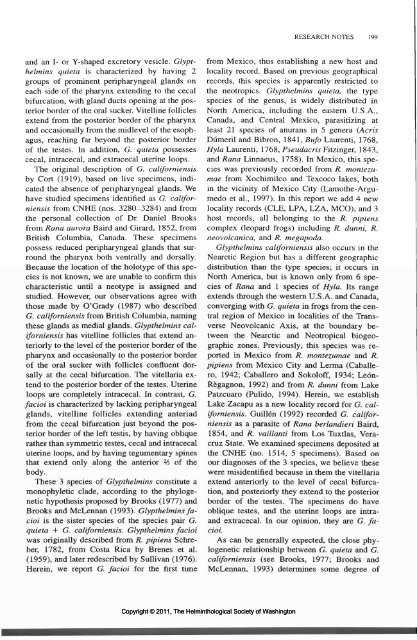The Helminthological Society of Washington - Peru State College
The Helminthological Society of Washington - Peru State College
The Helminthological Society of Washington - Peru State College
You also want an ePaper? Increase the reach of your titles
YUMPU automatically turns print PDFs into web optimized ePapers that Google loves.
RESEARCH NOTES 199<br />
and an I- or Y-shaped excretory vesicle. Glypthelmins<br />
quieta is characterized by having 2<br />
groups <strong>of</strong> prominent peripharyngeal glands on<br />
each side <strong>of</strong> the pharynx extending to the cecal<br />
bifurcation, with gland ducts opening at the posterior<br />
border <strong>of</strong> the oral sucker. Vitelline follicles<br />
extend from the posterior border <strong>of</strong> the pharynx<br />
and occasionally from the midlevel <strong>of</strong> the esophagus,<br />
reaching far beyond the posterior border<br />
<strong>of</strong> the testes. In addition, G. quieta possesses<br />
cecal, intracecal, and extracecal uterine loops.<br />
<strong>The</strong> original description <strong>of</strong> G. californiensis<br />
by Cort (1919), based on live specimens, indicated<br />
the absence <strong>of</strong> peripharyngeal glands. We<br />
have studied specimens identified as G. californiensis<br />
from CNHE (nos. 3280-3284) and from<br />
the personal collection <strong>of</strong> Dr. Daniel Brooks<br />
from Rana aurora Baird and Girard, 1852, from<br />
British Columbia, Canada. <strong>The</strong>se specimens<br />
possess reduced peripharyngeal glands that surround<br />
the pharynx both ventrally and dorsally.<br />
Because the location <strong>of</strong> the holotype <strong>of</strong> this species<br />
is not known, we are unable to confirm this<br />
characteristic until a neotype is assigned and<br />
studied. However, our observations agree with<br />
those made by O'Grady (1987) who described<br />
G. californiensis from British Columbia, naming<br />
these glands as medial glands. Glypthelmins californiensis<br />
has vitelline follicles that extend anteriorly<br />
to the level <strong>of</strong> the posterior border <strong>of</strong> the<br />
pharynx and occasionally to the posterior border<br />
<strong>of</strong> the oral sucker with follicles confluent dorsally<br />
at the cecal bifurcation. <strong>The</strong> vitellaria extend<br />
to the posterior border <strong>of</strong> the testes. Uterine<br />
loops are completely intracecal. In contrast, G.<br />
facioi is characterized by lacking peripharyngeal<br />
glands, vitelline follicles extending anteriad<br />
from the cecal bifurcation just beyond the posterior<br />
border <strong>of</strong> the left testis, by having oblique<br />
rather than symmetric testes, cecal and intracecal<br />
uterine loops, and by having tegumentary spines<br />
that extend only along the anterior % <strong>of</strong> the<br />
body.<br />
<strong>The</strong>se 3 species <strong>of</strong> Glypthelmins constitute a<br />
monophyletic clade, according to the phylogenetic<br />
hypothesis proposed by Brooks (1977) and<br />
Brooks and McLennan (1993). Glypthelmins facioi<br />
is the sister species <strong>of</strong> the species pair G.<br />
quieta + G. californiensis. Glypthelmins facioi<br />
was originally described from R. pipiens Schreber,<br />
1782, from Costa Rica by Brenes et al.<br />
(1959), and later redescribed by Sullivan (1976).<br />
Herein, we report G. facioi for the first time<br />
from Mexico, thus establishing a new host and<br />
locality record. Based on previous geographical<br />
records, this species is apparently restricted to<br />
the neotropics. Glypthelmins quieta, the type<br />
species <strong>of</strong> the genus, is widely distributed in<br />
North America, including the eastern U.S.A.,<br />
Canada, and Central Mexico, parasitizing at<br />
least 21 species <strong>of</strong> anurans in 5 genera (Acris<br />
Dumeril and Bibron, 1841, Bufo Laurenti, 1768,<br />
Hyla Laurenti, 1768, Pseudacris Fitzinger, 1843,<br />
and Rana Linnaeus, 1758). In Mexico, this species<br />
was previously recorded from R. montezumae<br />
from Xochimilco and Texcoco lakes, both<br />
in the vicinity <strong>of</strong> Mexico City (Lamothe-Argumedo<br />
et al., 1997). In this report we add 4 new<br />
locality records (CLE, LPA, LZA, MCO), and 3<br />
host records, all belonging to the R. pipiens<br />
complex (leopard frogs) including R. dunni, R.<br />
neovolcanica, and R. megapoda.<br />
Glypthelmins californiensis also occurs in the<br />
Nearctic Region but has a different geographic<br />
distribution than the type species; it occurs in<br />
North America, but is known only from 6 species<br />
<strong>of</strong> Rana and 1 species <strong>of</strong> Hyla. Its range<br />
extends through the western U.S.A. and Canada,<br />
converging with G. quieta in frogs from the central<br />
region <strong>of</strong> Mexico in localities <strong>of</strong> the Transverse<br />
Neovolcanic Axis, at the boundary between<br />
the Nearctic and Neotropical biogeographic<br />
zones. Previously, this species was reported<br />
in Mexico from R. montezumae and R.<br />
pipiens from Mexico City and Lerma (Caballero,<br />
1942; Caballero and Sokol<strong>of</strong>f, 1934; Leon-<br />
Regagnon, 1992) and from R. dunni from Lake<br />
Patzcuaro (Pulido, 1994). Herein, we establish<br />
Lake Zacapu as a new locality record for G. californiensis.<br />
Guillen (1992) recorded G. californiensis<br />
as a parasite <strong>of</strong> Rana berlandieri Baird,<br />
1854, and R. vaillanti from Los Tuxtlas, Veracruz<br />
<strong>State</strong>. We examined specimens deposited at<br />
the CNHE (no. 1514, 5 specimens). Based on<br />
our diagnoses <strong>of</strong> the 3 species, we believe these<br />
were misidentified because in them the vitellaria<br />
extend anteriorly to the level <strong>of</strong> cecal bifurcation,<br />
and posteriorly they extend to the posterior<br />
border <strong>of</strong> the testes. <strong>The</strong> specimens do have<br />
oblique testes, and the uterine loops are intraand<br />
extracecal. In our opinion, they are G. facioi.<br />
As can be generally expected, the close phylogenetic<br />
relationship between G. quieta and G.<br />
californiensis (see Brooks, 1977; Brooks and<br />
McLennan, 1993) determines some degree <strong>of</strong><br />
Copyright © 2011, <strong>The</strong> <strong>Helminthological</strong> <strong>Society</strong> <strong>of</strong> <strong>Washington</strong>
















